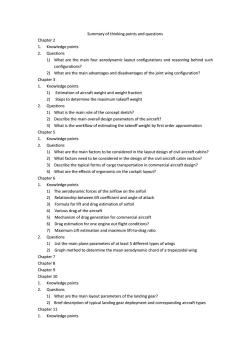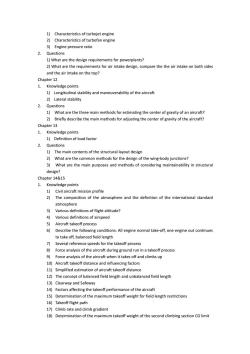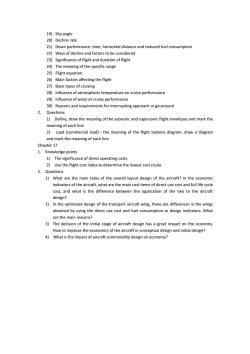上海交通大学:《飞机设计 Aircraft Design》课程教学资源_Knowledge Points and Questions_Summary of knowledge points and questions

Summary of thinking points and questions Chapter 2 1.Knowledge points 2.Questions 1)What are the main four aerodynamic layout configurations and reasoning behind such configurations? 2)What are the main advantages and disadvantages of the joint wing configuration? Chapter 3 1.Knowledge points 1)Estimation of aircraft weight and weight fraction 2)Steps to determine the maximum takeoff weight 2.Questions 1)What is the main role of the concept sketch? 2)Describe the main overall design parameters of the aircraft? 3)What is the workflow of estimating the takeoff weight by first order approximation Chapter 5 1.Knowledge points 2.Questions 1)What are the main factors to be considered in the layout design of civil aircraft cabins? 2)What factors need to be considered in the design of the civil aircraft cabin section? 3)Describe the typical forms of cargo transportation in commercial aircraft design? 4)What are the effects of ergonomic on the cockpit layout? Chapter 6 1.Knowledge points 1)The aerodynamic forces of the airflow on the airfoil 2)Relationship between lift coefficient and angle of attack 3)Formula for lift and drag estimation of airfoil 4)Various drag of the aircraft 5)Mechanism of drag generation for commercial aircraft 6)Drag estimation for one engine out flight conditions? 7)Maximum Lift estimation and maximum lift-to-drag ratio 2. Questions 1)List the main plane parameters of at least 5 different types of wings 2)Graph method to determine the mean aerodynamic chord of a trapezoidal wing Chapter 7 Chapter 8 Chapter 9 Chapter 10 1.Knowledge points 2.Questions 1)What are the main layout parameters of the landing gear? 2)Brief description of typical landing gear deployment and corresponding aircraft types Chapter 11 1.Knowledge points
Summary of thinking points and questions Chapter 2 1. Knowledge points 2. Questions 1) What are the main four aerodynamic layout configurations and reasoning behind such configurations? 2) What are the main advantages and disadvantages of the joint wing configuration? Chapter 3 1. Knowledge points 1) Estimation of aircraft weight and weight fraction 2) Steps to determine the maximum takeoff weight 2. Questions 1) What is the main role of the concept sketch? 2) Describe the main overall design parameters of the aircraft? 3) What is the workflow of estimating the takeoff weight by first order approximation Chapter 5 1. Knowledge points 2. Questions 1) What are the main factors to be considered in the layout design of civil aircraft cabins? 2) What factors need to be considered in the design of the civil aircraft cabin section? 3) Describe the typical forms of cargo transportation in commercial aircraft design? 4) What are the effects of ergonomic on the cockpit layout? Chapter 6 1. Knowledge points 1) The aerodynamic forces of the airflow on the airfoil 2) Relationship between lift coefficient and angle of attack 3) Formula for lift and drag estimation of airfoil 4) Various drag of the aircraft 5) Mechanism of drag generation for commercial aircraft 6) Drag estimation for one engine out flight conditions? 7) Maximum Lift estimation and maximum lift-to-drag ratio 2. Questions 1) List the main plane parameters of at least 5 different types of wings 2) Graph method to determine the mean aerodynamic chord of a trapezoidal wing Chapter 7 Chapter 8 Chapter 9 Chapter 10 1. Knowledge points 2. Questions 1) What are the main layout parameters of the landing gear? 2) Brief description of typical landing gear deployment and corresponding aircraft types Chapter 11 1. Knowledge points

1)Characteristics of turbojet engine 2)Characteristics of turbofan engine 3)Engine pressure ratio 2. Questions 1)What are the design requirements for powerplants? 2)What are the requirements for air intake design,compare the the air intake on both sides and the air intake on the top? Chapter 12 1.Knowledge points 1)Longitudinal stability and maneuverability of the aircraft 2)Lateral stability 2.Questions 1)What are the three main methods for estimating the center of gravity of an aircraft? 2)Briefly describe the main methods for adjusting the center of gravity of the aircraft? Chapter 13 1.Knowledge points 1)Definition of load factor 2.Questions 1)The main contents of the structural layout design 2)What are the common methods for the design of the wing-body junctions? 3)What are the main purposes and methods of considering maintainability in structural design? Chapter 14&15 1.Knowledge points 1)Civil aircraft mission profile 2)The composition of the atmosphere and the definition of the international standard atmosphere 3)Various definitions of flight altitude? A Various definitions of airspeed 5)Aircraft takeoff process 6 Describe the following conditions:All engine normal take-off,one engine out continues to take off,balanced field length 7)Several reference speeds for the takeoff process 8 Force analysis of the aircraft during ground run in a takeoff process 9)Force analysis of the aircraft when it takes off and climbs up 10)Aircraft takeoff distance and influencing factors 11)Simplified estimation of aircraft takeoff distance 12)The concept of balanced field length and unbalanced field length 13)Clearway and Safeway 14)Factors affecting the takeoff performance of the aircraft 15)Determination of the maximum takeoff weight for field length restrictions 16)Takeoff flight path 17)Climb rate and climb gradient 18)Determination of the maximum takeoff weight of the second climbing section CG limit
1) Characteristics of turbojet engine 2) Characteristics of turbofan engine 3) Engine pressure ratio 2. Questions 1) What are the design requirements for powerplants? 2) What are the requirements for air intake design, compare the the air intake on both sides and the air intake on the top? Chapter 12 1. Knowledge points 1) Longitudinal stability and maneuverability of the aircraft 2) Lateral stability 2. Questions 1) What are the three main methods for estimating the center of gravity of an aircraft? 2) Briefly describe the main methods for adjusting the center of gravity of the aircraft? Chapter 13 1. Knowledge points 1) Definition of load factor 2. Questions 1) The main contents of the structural layout design 2) What are the common methods for the design of the wing-body junctions? 3) What are the main purposes and methods of considering maintainability in structural design? Chapter 14&15 1. Knowledge points 1) Civil aircraft mission profile 2) The composition of the atmosphere and the definition of the international standard atmosphere 3) Various definitions of flight altitude? 4) Various definitions of airspeed 5) Aircraft takeoff process 6) Describe the following conditions: All engine normal take-off, one engine out continues to take off, balanced field length 7) Several reference speeds for the takeoff process 8) Force analysis of the aircraft during ground run in a takeoff process 9) Force analysis of the aircraft when it takes off and climbs up 10) Aircraft takeoff distance and influencing factors 11) Simplified estimation of aircraft takeoff distance 12) The concept of balanced field length and unbalanced field length 13) Clearway and Safeway 14) Factors affecting the takeoff performance of the aircraft 15) Determination of the maximum takeoff weight for field length restrictions 16) Takeoff flight path 17) Climb rate and climb gradient 18) Determination of the maximum takeoff weight of the second climbing section CG limit

19)Slip angle 20)Decline rate 21)Down performance:time,horizontal distance and reduced fuel consumption 22)Ways of decline and factors to be considered 23)Significance of flight and duration of flight 24)The meaning of the specific range 25)Flight equation 26)Main factors affecting the flight 27)Basic types of cruising 28)Influence of atmospheric temperature on cruise performance 29)Influence of wind on cruise performance 30)Reasons and requirements for interrupting approach or go-around 2.Questions 1)Define,draw the meaning of the subsonic and supersonic flight envelopes and mark the meaning of each line 2)Load(commercial load)-the meaning of the flight balance diagram,draw a diagram and mark the meaning of each line Chapter 17 1.Knowledge points 1)The significance of direct operating costs 2)Use the flight cost index to determine the lowest cost cruise 2.Questions 1)What are the main tasks of the overall layout design of the aircraft?In the economic indicators of the aircraft,what are the main cost items of direct use cost and full life cycle cost,and what is the difference between the application of the two to the aircraft design? 2)In the optimized design of the transport aircraft wing,there are differences in the wings obtained by using the direct use cost and fuel consumption as design indicators.What are the main reasons? 3)The decision of the initial stage of aircraft design has a great impact on the economy. How to improve the economics of the aircraft in conceptual design and initial design? 4)What is the impact of aircraft commonality design on economy?
19) Slip angle 20) Decline rate 21) Down performance: time, horizontal distance and reduced fuel consumption 22) Ways of decline and factors to be considered 23) Significance of flight and duration of flight 24) The meaning of the specific range 25) Flight equation 26) Main factors affecting the flight 27) Basic types of cruising 28) Influence of atmospheric temperature on cruise performance 29) Influence of wind on cruise performance 30) Reasons and requirements for interrupting approach or go-around 2. Questions 1) Define, draw the meaning of the subsonic and supersonic flight envelopes and mark the meaning of each line 2) Load (commercial load) - the meaning of the flight balance diagram, draw a diagram and mark the meaning of each line Chapter 17 1. Knowledge points 1) The significance of direct operating costs 2) Use the flight cost index to determine the lowest cost cruise 2. Questions 1) What are the main tasks of the overall layout design of the aircraft? In the economic indicators of the aircraft, what are the main cost items of direct use cost and full life cycle cost, and what is the difference between the application of the two to the aircraft design? 2) In the optimized design of the transport aircraft wing, there are differences in the wings obtained by using the direct use cost and fuel consumption as design indicators. What are the main reasons? 3) The decision of the initial stage of aircraft design has a great impact on the economy. How to improve the economics of the aircraft in conceptual design and initial design? 4) What is the impact of aircraft commonality design on economy?
按次数下载不扣除下载券;
注册用户24小时内重复下载只扣除一次;
顺序:VIP每日次数-->可用次数-->下载券;
- 民用航空器维修基础系列教材:《航空器维修Aircraft Maintenance》第2册PDF电子书(共三部分七章).pdf
- 北京大学:《太空探索》精品课程教学资源(PPT课件)第八章 探索太空的秘密(寻找地外生命).ppt
- 北京大学:《太空探索》精品课程教学资源(PPT课件)第十章 太空资源及其应用.ppt
- 北京大学:《太空探索》精品课程教学资源(PPT课件)第十二章 太空灾害及预防.ppt
- 北京大学:《太空探索》精品课程教学资源(PPT课件)第十一章 现代战争与空间天气(主讲:焦维新).ppt
- 北京大学:《太空探索》精品课程教学资源(PPT课件)第五章 宇宙 5.1 恒星及其演化 5.2 宇宙的结构.ppt
- 北京大学:《太空探索》精品课程教学资源(PPT课件)第九章 载人航天(载人航天的类型、载人航天的发展历程、载人航天的科学、商业和军事应用).ppt
- 北京大学:《太空探索》精品课程教学资源(PPT课件)第三章 日地空间(太阳与太阳风).ppt
- 北京大学:《太空探索》精品课程教学资源(PPT课件)第七章 探索太空的航天器.ppt
- 北京大学:《太空探索》精品课程教学资源(PPT课件)第四章 日球空间(太阳系).ppt
- 北京大学:《太空探索》精品课程教学资源(PPT课件)第四章 日球空间(类木行星与外太阳系).ppt
- 北京大学:《太空探索》精品课程教学资源(PPT课件)第四章 日球空间(月球文化与月球探测).ppt
- 北京大学:《太空探索》精品课程教学资源(PPT课件)第二篇 探索太空 第六章 太空飞行基础.ppt
- 北京大学:《太空探索》精品课程教学资源(PPT课件)第二章 地球空间(磁层与辐射带).ppt
- 北京大学:《太空探索》精品课程教学资源(PPT课件)第二章 地球空间(大气层与电离层).ppt
- 北京大学:《太空探索》精品课程教学资源(PPT课件)课程概述、第一章 绚丽多彩的太空(焦维新、傅遂燕、谢伦).ppt
- 南京航空航天大学:航空发动机磨损故障智能诊断若干关键技术研究及专家系统开发(博士学位论文答辩).ppt
- 民航飞行标准培训中心:91部运行的飞行员政策解读(2012年6月).pptx
- 惯性导航系统实施区域导航(PPT讲稿).ppt
- 民航飞行标准培训中心:面向CCAR-121部飞行员培训(PPT讲稿)CCAR-141部飞机类商用执照课程.ppt
- 上海交通大学:《飞机设计 Aircraft Design》课程教学资源_Knowledge Points and Questions_各章思考要点及思考题汇总.docx
- 上海交通大学:《飞机设计 Aircraft Design》课程教学资源_Project Report_Design Project Report List.pdf
- 上海交通大学:《飞机设计 Aircraft Design》课程教学资源_Project Report_Project Report_2013Group 1 - 超音速客机设计.pdf
- 上海交通大学:《飞机设计 Aircraft Design》课程教学资源_Project Report_Project Report_2013Group 2 - 中短程宽体客机设计.pdf
- 上海交通大学:《飞机设计 Aircraft Design》课程教学资源_Project Report_Project Report_2013Group 3 - 民用倾转旋翼机设计.pdf
- 上海交通大学:《飞机设计 Aircraft Design》课程教学资源_Project Report_Project Report_2013Group 4 - 中远程宽体客机设计.pdf
- 上海交通大学:《飞机设计 Aircraft Design》课程教学资源_Project Report_Project Report_2013Group 5 - 超音速客机设计.pdf
- 上海交通大学:《飞机设计 Aircraft Design》课程教学资源_Project Report_Project Report_2014Group 1 - 超音速客机设计.pdf
- 上海交通大学:《飞机设计 Aircraft Design》课程教学资源_Project Report_Project Report_2014Group 2 - 中短程宽体客机设计.pdf
- 上海交通大学:《飞机设计 Aircraft Design》课程教学资源_Project Report_Project Report_2014Group 3 - 民用倾转旋翼机设计.pdf
- 上海交通大学:《飞机设计 Aircraft Design》课程教学资源_Project Report_Project Report_2014Group 4 - 中远程宽体客机设计.pdf
- 上海交通大学:《飞机设计 Aircraft Design》课程教学资源_Project Report_Project Report_2015Group A - Amphibious Transport Aircraft.pdf
- 上海交通大学:《飞机设计 Aircraft Design》课程教学资源_Project Report_Project Report_2015Group B - The Wide-Body PIS-413 for Domestic Market in China.pdf
- 上海交通大学:《飞机设计 Aircraft Design》课程教学资源_Project Report_Project Report_2015Group C - The Air Taxi.pdf
- 上海交通大学:《飞机设计 Aircraft Design》课程教学资源_Project Report_Project Report_2015Group D - A High Altitude Long Endurance Uav.pdf
- 上海交通大学:《飞机设计 Aircraft Design》课程教学资源_Project Report_Project Report_2015Group E - Supersonic Business Jet SBJ.pdf
- 上海交通大学:《飞机设计 Aircraft Design》课程教学资源_参考资料_1_AIAA-5119-671 Case for Small Supersonic Civil Aircraft.pdf
- 上海交通大学:《飞机设计 Aircraft Design》课程教学资源_参考资料_31_preliminary definition of supersonic and hypersonic airliner configurations AIAA-2006-7984-634.pdf
- 上海交通大学:《飞机设计 Aircraft Design》课程教学资源_参考资料_32_advanced concept studies for supersonic commercial transports entering service in 2030-35 N+3 AIAA-2010-5114-736.pdf
- 上海交通大学:《飞机设计 Aircraft Design》课程教学资源_参考资料_36_engine options for supersonic cruise aircraft AIAA-1978-1054-507.pdf
